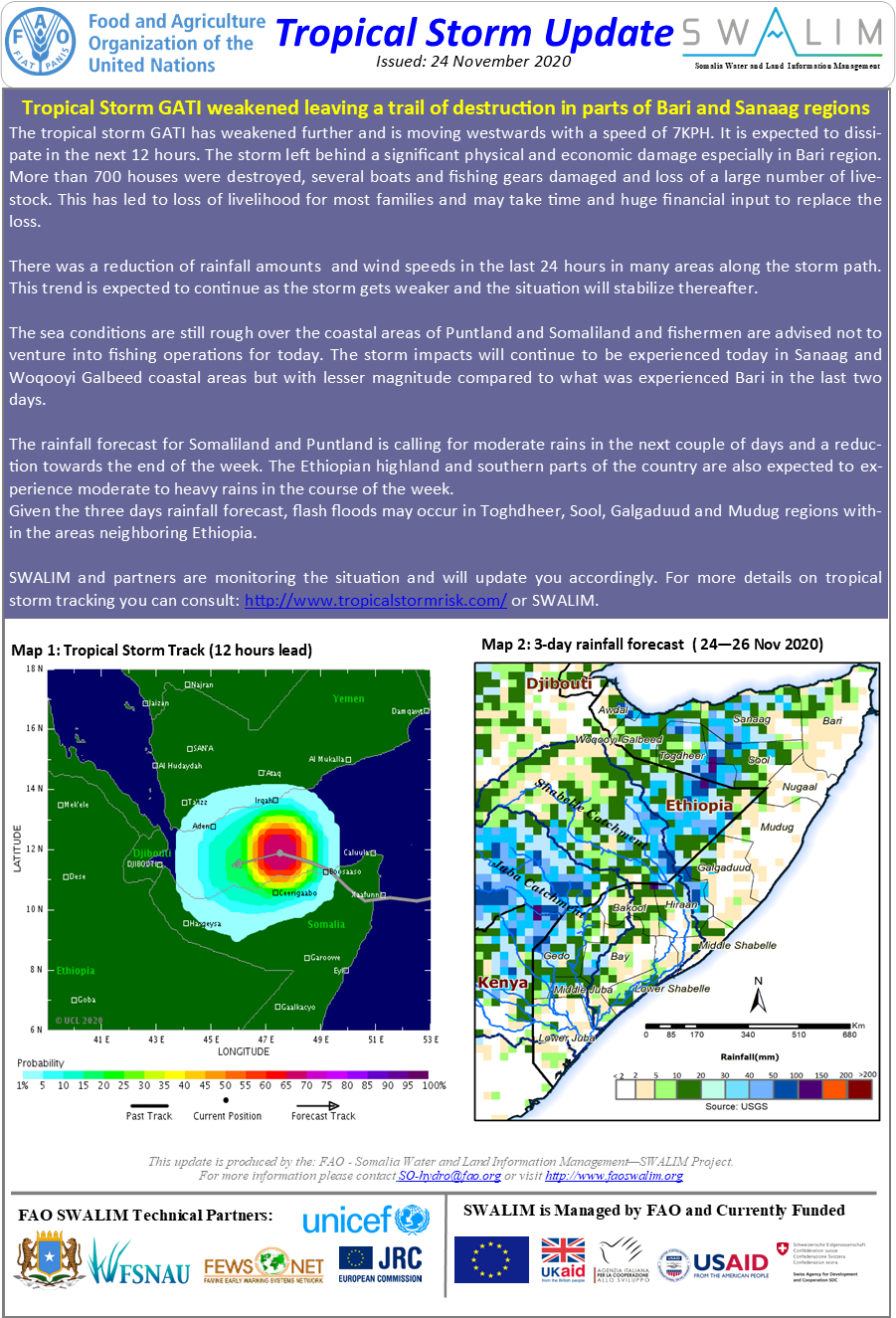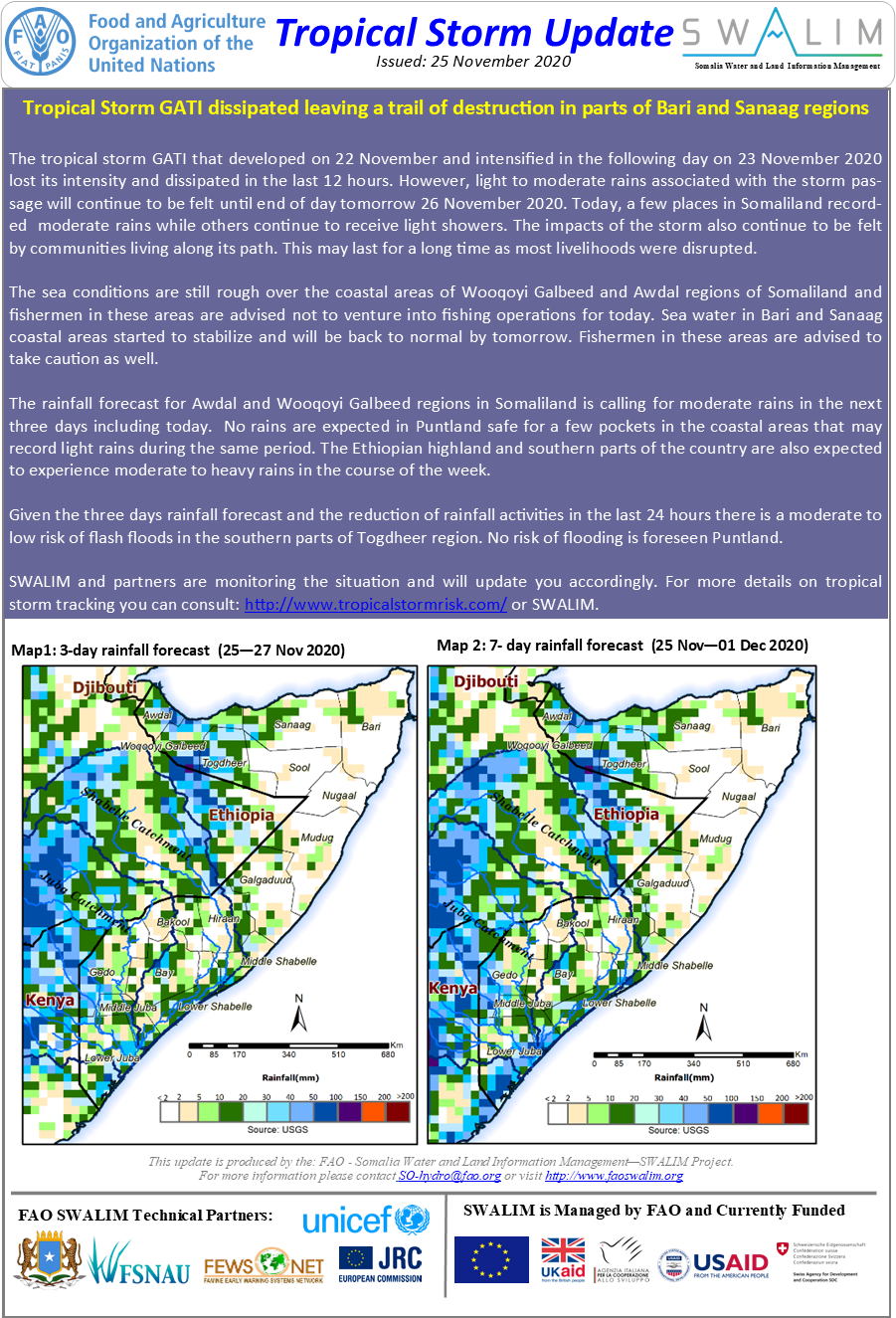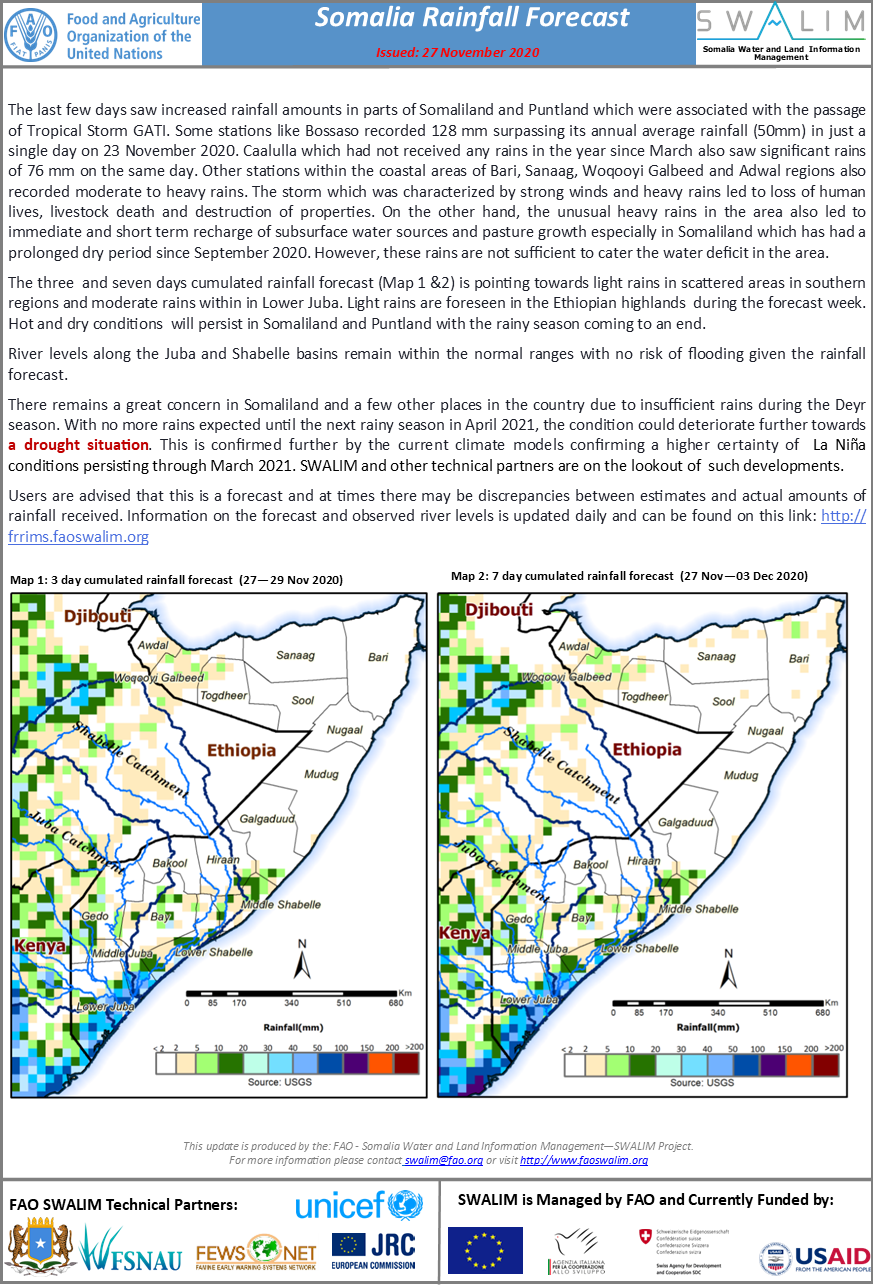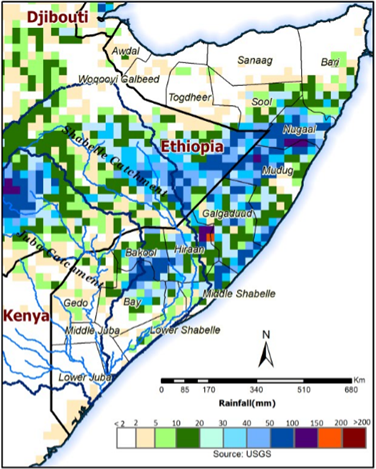Library Catalog
Latest Documents and Publications listed. Use search terms in the box below to find what you need
Somalia Rainfall Forecast - Issued 12 November 2020
There has been a significant decline of rainfall amounts across Somalia over the last week. In the north western regions of Awdal, Wooqoyi Galbeed and Toghdheer, a prolonged dry period has been observed since the last week of September 2020. Most stations in these regions recorded little or no rainfall during the month of October 2020. Similarly, parts of Puntland have not received any rains since the first week of October. There also remains a significant rainfall deficit in most parts of the southern regions and especially the Jubas and Lower Shabelle.
The last week saw a reduction of river levels along the Shabelle River. Currently, levels are within normal in Belet Weyne and Bulo Burti districts while the mid and lower reaches are still at high levels. In Agfooye, the levels are at full capacity and most parts of the riverine areas remain inundated with massive displacement being reported in the area. River levels along the Juba increased sharply in the last one week reaching alarming levels in Bardheere. This was due to heavy rains in the upper reaches of the Ethiopian side which also led to river flooding in Dollow. The last three days have however seen a reduction of the levels along the channel.
The cumulative rainfall forecast for this week suggests a significant reduction of rainfall amounts across the country with light rains along the southern coastal areas. Little or no rainfall is foreseen in the Ethiopian highlands. This will subsequently lead to a decrease in river levels especially along the Shabelle river.
Given the rainfall forecast, No risk of flooding is foreseen along the Juba and Shabelle rivers. There is however a great concern of moisture deficits across the country especially in the rain fed agricultural areas of the southern regions. Drought conditions are foreseen if the trend continues.
Publication Type:
Rainfall Forecast
Publication Date:
Author:
Corporate Author:
Tropical Storm Update - Issued: 24 November 2020
Tropical Storm GATI weakened leaving a trail of destruction in parts of Bari and Sanaag regions
The tropical storm GATI has weakened further and is moving westwards with a speed of 7KPH. It is expected to dissipate in the next 12 hours. The storm left behind a significant physical and economic damage especially in Bari region. More than 700 houses were destroyed, several boats and fishing gears damaged and loss of a large number of livestock. This has led to loss of livelihood for most families and may take time and huge financial input to replace the loss.
There was a reduction of rainfall amounts and wind speeds in the last 24 hours in many areas along the storm path. This trend is expected to continue as the storm gets weaker and the situation will stabilize thereafter.
The sea conditions are still rough over the coastal areas of Puntland and Somaliland and fishermen are advised not to venture into fishing operations for today. The storm impacts will continue to be experienced today in Sanaag and Woqooyi Galbeed coastal areas but with lesser magnitude compared to what was experienced Bari in the last two days.
The rainfall forecast for Somaliland and Puntland is calling for moderate rains in the next couple of days and a reduction towards the end of the week. The Ethiopian highland and southern parts of the country are also expected to experience moderate to heavy rains in the course of the week.
Given the three days rainfall forecast, flash floods may occur in Toghdheer, Sool, Galgaduud and Mudug regions within the areas neighboring Ethiopia.
Publication Type:
Storm Alert
Publication Date:
Author:
Corporate Author:
Tropical Storm Update - Issued: 25 November 2020
Tropical Storm GATI dissipated leaving a trail of destruction in parts of Bari and Sanaag regions
The tropical storm GATI that developed on 22 November and intensified in the following day on 23 November 2020 lost its intensity and dissipated in the last 12 hours. However, light to moderate rains associated with the storm passage will continue to be felt until end of day tomorrow 26 November 2020. Today, a few places in Somaliland recorded moderate rains while others continue to receive light showers. The impacts of the storm also continue to be felt by communities living along its path. This may last for a long time as most livelihoods were disrupted.
The sea conditions are still rough over the coastal areas of Wooqoyi Galbeed and Awdal regions of Somaliland and fishermen in these areas are advised not to venture into fishing operations for today. Sea water in Bari and Sanaag coastal areas started to stabilize and will be back to normal by tomorrow. Fishermen in these areas are advised to take caution as well.
The rainfall forecast for Awdal and Wooqoyi Galbeed regions in Somaliland is calling for moderate rains in the next three days including today. No rains are expected in Puntland safe for a few pockets in the coastal areas that may record light rains during the same period. The Ethiopian highland and southern parts of the country are also expected to experience moderate to heavy rains in the course of the week.
Given the three days rainfall forecast and the reduction of rainfall activities in the last 24 hours there is a moderate to low risk of flash floods in the southern parts of Togdheer region. No risk of flooding is foreseen Puntland.
Publication Type:
Storm Alert
Publication Date:
Author:
Corporate Author:
Somalia Rainfall Forecast - Issued: 27 November 2020
The last few days saw increased rainfall amounts in parts of Somaliland and Puntland which were associated with the passage of Tropical Storm GATI. Some stations like Bossaso recorded 128 mm surpassing its annual average rainfall (50mm) in just a single day on 23 November 2020. Caalulla which had not received any rains in the year since March also saw significant rains of 76 mm on the same day. Other stations within the coastal areas of Bari, Sanaag, Woqooyi Galbeed and Adwal regions also recorded moderate to heavy rains. The storm which was characterized by strong winds and heavy rains led to loss of human lives, livestock death and destruction of properties. On the other hand, the unusual heavy rains in the area also led to immediate and short term recharge of subsurface water sources and pasture growth especially in Somaliland which has had a prolonged dry period since September 2020. However, these rains are not sufficient to cater the water deficit in the area.
The three and seven days cumulated rainfall forecast (Map 1 &2) is pointing towards light rains in scattered areas in southern regions and moderate rains within in Lower Juba. Light rains are foreseen in the Ethiopian highlands during the forecast week. Hot and dry conditions will persist in Somaliland and Puntland with the rainy season coming to an end.
River levels along the Juba and Shabelle basins remain within the normal ranges with no risk of flooding given the rainfall forecast.
There remains a great concern in Somaliland and a few other places in the country due to insufficient rains during the Deyr season. With no more rains expected until the next rainy season in April 2021, the condition could deteriorate further towards a drought situation. This is confirmed further by the current climate models confirming a higher certainty of La Niña conditions persisting through March 2021. SWALIM and other technical partners are on the lookout of such developments.
Publication Type:
Rainfall Forecast
Publication Date:
Author:
Corporate Author:
Somalia Rainfall Forecast - Issued: 02 October 2020
Moderate to heavy rains are foreseen in parts of Puntland and central regions within this week. In particular, Hiraan, Bakool, Galgaduud, Mudug, Nugaal and southern parts of Sool region will receive significant rainfall amounts during the forecast period. The Ethiopian highland will also receive moderate to heavy rains during the same period.
Heavy storms are expected between 03 and 05 October in Nugaal, Mudug, Galgaduud and Hiraan regions. This is likely to lead to flash floods the areas.
Given the rainfall forecast and current situation along the two rivers, High Risk of flooding remains along the Shabelle while there is no risk of flooding foreseen along the Juba River. There is a also a high risk of flash floods in the built up low lying areas of central regions, Bakool, Nugaal and Sool.
Publication Type:
Rainfall Forecast
Publication Date:
Author:
Corporate Author:
Somalia Rainfall Forecast - Issued: 19 October 2020
The Deyr 2020 rainy season (Sept/Oct—Dec) continued to spread in the north eastern parts of Somalia and a few places in the south during the last two weeks. A dry period was observed in Somaliland which has not recorded any rains since the beginning of the month. Low to moderate rains were observed in the Ethiopian highlands during the same period.
There was a fluctuation of river along the Juba and Shabelle Rivers. Currently, levels are significantly above normal along the Shabelle. Today’s River level at Belet Weyne is 7.58m which has surpassed the high risk level of flooding. Similarly, the levels are high in the mid and lower reaches of the river. Todays river level at Jowhar is 5. 25m which is almost at bank-ful. In Agfooye, the levels are at full capacity and most parts of the riverine areas remain inundated. A recent ground survey by SWALIM indicates that there are several open and weak river embankments in Jowhar, Balcad and Afgooye districts with some ranging from 500m to 1,000m wide. Some villages continue to be under water since August 2020. River levels are within normal along the Juba.
The cumulative rainfall forecast for this week indicates moderate to heavy rains in central and parts of southern regions including, Nugaal, Mudug, Galgaduud, Hiraan and Bakool regions. No rains are expected along the Juba and in Somaliland during the forecast period.
The Ethiopian highlands whose soil moisture is already saturated due to heavy rains since July 2020 will see an increase of rainfall amounts this week. This will subsequently lead to a further increase in river levels especially along the Shabelle river.
Given the rainfall forecast and current situation along the two rivers, High Risk of flooding remains along the Shabelle while there is no risk of flooding foreseen along the Juba River. There is a also a high risk of flash floods in the built up low lying areas especially in Mudug and Galgaduud regions
Publication Type:
Rainfall Forecast
Publication Date:
Author:
Corporate Author:
Somalia Rainfall Forecast - Issued: 26 October 2020
The Deyr 2020 rainy season (Sept/Oct—Dec) continued to spread in a few places during the last week. A dry period was observed in greater parts of Somaliland which has not recorded any rains since the beginning of the month. Light to moderate rains were observed in the Ethiopian highlands during the same period.
The last few days saw a reduction of river levels along the Shabelle. Currently, levels are within normal in Belet Weyne and Bulo Burti districts while the mid and lower reaches are still at high levels. Today’s River level at Belet Weyne is 5.25m, a drastic drop from last week; while in Jowhar the level is 5.20m, which is almost at bank-ful. In Agfooye, the levels are at full capacity and most parts of the riverine areas remain inundated. A recent ground survey by SWALIM indicates that there are several open and weak river embankments in Jowhar, Balcad and Afgooye districts with some ranging from 500m to 1,000m wide. Some villages continue to be under water since August 2020. River levels along the Juba increased slightly during the last few days due to moderate rains in the Ethiopian highlands.
The cumulative rainfall forecast for this week indicates moderate to heavy rains in many areas across the country, with minimal rains in the western parts of Somaliland and south of Bari region in Puntland.
The Ethiopian highlands whose soil moisture is already saturated due to heavy rains since July 2020 will see an increase of rainfall amounts this week. This will subsequently lead to a further increase in river levels especially along the Shabelle river.
Given the rainfall forecast and current situation along the two rivers, High Risk of flooding remains along the lower reaches of Shabelle while along the Juba River there is Moderate Risk of flooding foreseen . There is a also a High Risk of flash floods in the built up low lying areas especially in Bay and Bakool regions
Publication Type:
Rainfall Forecast
Publication Date:
Author:
Corporate Author:
Somalia Rainfall Forecast - Issued: 29 October 2020
Many places received light to moderate rains across Somalia in the last two days as the Deyr rainy season continued to spread albeit with a delay in some areas. Hiraan, Bakool and Bay regions in the south recorded heavy rains of up to 60mm within 24 hours. Light to moderate rains were observed in the Ethiopian highlands during the same period.
River levels are within normal in Belet Weyne and Bulo Burti districts while the mid and lower reaches are still at high levels. Today’s River level at Belet Weyne is 5.00m while Jowhar is 5.25m which is almost at bank-ful. In Agfooye, the levels are at full capacity and most parts of the riverine areas remain inundated. A recent ground survey by SWALIM indicates that there are several open and weak river embankments in Jowhar, Balcad and Afgooye districts with some ranging from 500m to 1,000m wide. Some villages continue to be under water since August 2020. River levels along the Juba increased slightly during the last few days due to moderate rains in the Ethiopian highlands.
The cumulative rainfall forecast for this week indicates moderate to heavy rains in many areas across the country. In the western parts of Somaliland and south of Bari region in Puntland the rains will be less.
The Ethiopian highlands whose soil moisture is already saturated due to heavy rains since July 2020 will see an increase of rainfall amounts this week. This will subsequently lead to a further increase in river levels especially along the Shabelle river.
Given the rainfall forecast and current situation along the two rivers, High Risk of flooding remains along the lower reaches of Shabelle while along the Juba River there is Moderate Risk of flooding foreseen . There is a also a High Risk of flash floods in the built up low lying areas especially in Galgaduud, Mudug, Bay and Bakool regions
Publication Type:
Rainfall Forecast
Publication Date:
Author:
Corporate Author:
Status of River Breakages Along Juba and Shabelle Rivers - Issued September 2020
Following three consecutive significant rainy seasons, (Dery 2019, Gu 2020 and Hagaa 2020-traditionally dry) river levels along the Juba and Shabelle Rivers have remained high for a long period with flooding due to overbank spillage and existing river breakages/weak embankments. The high rains and subsequent floods of Gu 2020 saw new open river banks.
SWALIM has updated the status of the river breakages along the Juba and Shabelle Rivers using available Very High Resolution (VHR) satellite imagery and a Digital Elevation Model (DEM); supported by “limited ground truthing” field observations, where feasible.
Four types of breakages have been identified, namely; open, overflow, potential overflows and closed with sandbags. The open breakages are those that are currently open as observed on the latest VHR image available. The open breakages are further categorised into four classes in a chronological order, according to the assessment date and/or their former status as seen in the maps. All the observations reported refers to the latest suitable VHR satellite image available, which is indicated in the online database.
154 Open points have been identified, 109 on the Shabelle River and 45 on the Juba River which require immediate action. It is noted that several new breakages occurred during the Gu 2020 season which was exceptionally good along the two rivers. Belet Weyne district was worst affected along the Shabelle while Bu’aale district was worst affected along the Juba.
SWALIM has also embarked on a ground truthing survey along the Shabelle River in Jowhar, Balcad and Afgooye districts. The survey aims to monitor existing open and weak riverbanks while capturing the dimensions of each point. The findings of the survey will be key to planning and interventions on those points.
SWALIM is pleased to share with you maps and tables of the status of river breakages along the two rivers in the links below. This information is also available on the SWALIM website. Users are advised that the methodology is biased towards Remote Sensing (RS) interpretation with only limited “ground truthing” due to access constraints. Open breakages might have been omitted in some cases where satellite images may not have been very clear (e.g. heavy cloud cover) or were not available.
Publication Type:
Map
Publication Date:
Author:
Corporate Author:
Somalia Rainfall Forecast - Issued: 30 September 2020
n the south. Heavy rains were reported in parts of Sool and Sanaag regions in the last 24 hours. Las Caanood recorded a total of 97mm and Taleex received a total of 49mm on 30 September 2020. Qardo station also recorded heavy amounts of 30mm. The southern parts of the country recorded little or no rains in the last few days.
There was reduction of rainfall amounts within the Ethiopian highlands over the last week. This subsequently led to a slight reduction of river flow along the Shabelle River. However, river levels are still very high along the entire channel and flooding continue to be reported in parts of the riverine areas. In Belet Weyne and Bulo Burti, the river levels are still above the high flood risk level to date.
The cumulative rainfall forecast for this week indicates moderate to heavy rains in Sanaag, Sool, Nugaal, Mudug, Galgaduud, Hiraan and Bakool regions. Light to moderate rains are expected in Somaliland and most parts of the southern regions during the forecast period.
The Ethiopian highlands whose soil moisture is already saturated due to heavy rains since July 2020 will see an increase of rainfall amounts this week. This will subsequently lead to a further increase in river levels especially along the Shabelle river.
Given the rainfall forecast and current situation along the two rivers, High Risk of flooding remains along the Shabelle while there is no risk of flooding foreseen along the Juba River. There is a also a high risk of flash floods in the built up low lying areas of central regions, Bakool, Nugaal and Sool.
Publication Type:
Rainfall Forecast
Publication Date:
Author:
Corporate Author:
Pages
 RSS feed [compliant with the Agris AP] |
RSS feed [compliant with the Agris AP] |  Agris AP XML
Agris AP XML





